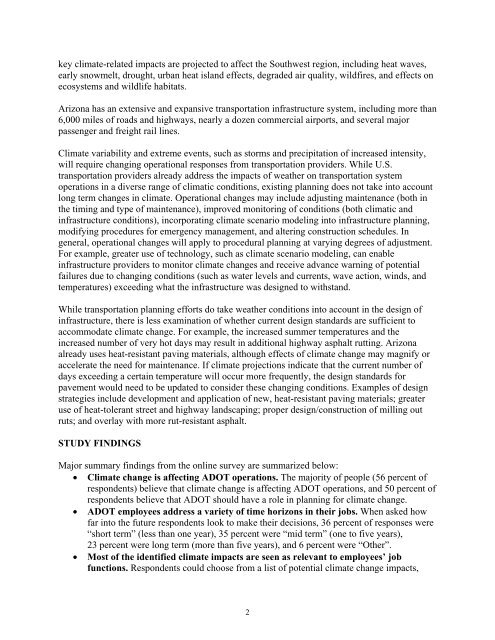SPR-696: Preliminary Study of Climate Adaptation for the Statewide ...
SPR-696: Preliminary Study of Climate Adaptation for the Statewide ...
SPR-696: Preliminary Study of Climate Adaptation for the Statewide ...
You also want an ePaper? Increase the reach of your titles
YUMPU automatically turns print PDFs into web optimized ePapers that Google loves.
key climate-related impacts are projected to affect <strong>the</strong> Southwest region, including heat waves,early snowmelt, drought, urban heat island effects, degraded air quality, wildfires, and effects onecosystems and wildlife habitats.Arizona has an extensive and expansive transportation infrastructure system, including more than6,000 miles <strong>of</strong> roads and highways, nearly a dozen commercial airports, and several majorpassenger and freight rail lines.<strong>Climate</strong> variability and extreme events, such as storms and precipitation <strong>of</strong> increased intensity,will require changing operational responses from transportation providers. While U.S.transportation providers already address <strong>the</strong> impacts <strong>of</strong> wea<strong>the</strong>r on transportation systemoperations in a diverse range <strong>of</strong> climatic conditions, existing planning does not take into accountlong term changes in climate. Operational changes may include adjusting maintenance (both in<strong>the</strong> timing and type <strong>of</strong> maintenance), improved monitoring <strong>of</strong> conditions (both climatic andinfrastructure conditions), incorporating climate scenario modeling into infrastructure planning,modifying procedures <strong>for</strong> emergency management, and altering construction schedules. Ingeneral, operational changes will apply to procedural planning at varying degrees <strong>of</strong> adjustment.For example, greater use <strong>of</strong> technology, such as climate scenario modeling, can enableinfrastructure providers to monitor climate changes and receive advance warning <strong>of</strong> potentialfailures due to changing conditions (such as water levels and currents, wave action, winds, andtemperatures) exceeding what <strong>the</strong> infrastructure was designed to withstand.While transportation planning ef<strong>for</strong>ts do take wea<strong>the</strong>r conditions into account in <strong>the</strong> design <strong>of</strong>infrastructure, <strong>the</strong>re is less examination <strong>of</strong> whe<strong>the</strong>r current design standards are sufficient toaccommodate climate change. For example, <strong>the</strong> increased summer temperatures and <strong>the</strong>increased number <strong>of</strong> very hot days may result in additional highway asphalt rutting. Arizonaalready uses heat-resistant paving materials, although effects <strong>of</strong> climate change may magnify oraccelerate <strong>the</strong> need <strong>for</strong> maintenance. If climate projections indicate that <strong>the</strong> current number <strong>of</strong>days exceeding a certain temperature will occur more frequently, <strong>the</strong> design standards <strong>for</strong>pavement would need to be updated to consider <strong>the</strong>se changing conditions. Examples <strong>of</strong> designstrategies include development and application <strong>of</strong> new, heat-resistant paving materials; greateruse <strong>of</strong> heat-tolerant street and highway landscaping; proper design/construction <strong>of</strong> milling outruts; and overlay with more rut-resistant asphalt.STUDY FINDINGSMajor summary findings from <strong>the</strong> online survey are summarized below: <strong>Climate</strong> change is affecting ADOT operations. The majority <strong>of</strong> people (56 percent <strong>of</strong>respondents) believe that climate change is affecting ADOT operations, and 50 percent <strong>of</strong>respondents believe that ADOT should have a role in planning <strong>for</strong> climate change. ADOT employees address a variety <strong>of</strong> time horizons in <strong>the</strong>ir jobs. When asked howfar into <strong>the</strong> future respondents look to make <strong>the</strong>ir decisions, 36 percent <strong>of</strong> responses were“short term” (less than one year), 35 percent were “mid term” (one to five years),23 percent were long term (more than five years), and 6 percent were “O<strong>the</strong>r”. Most <strong>of</strong> <strong>the</strong> identified climate impacts are seen as relevant to employees’ jobfunctions. Respondents could choose from a list <strong>of</strong> potential climate change impacts,2
















